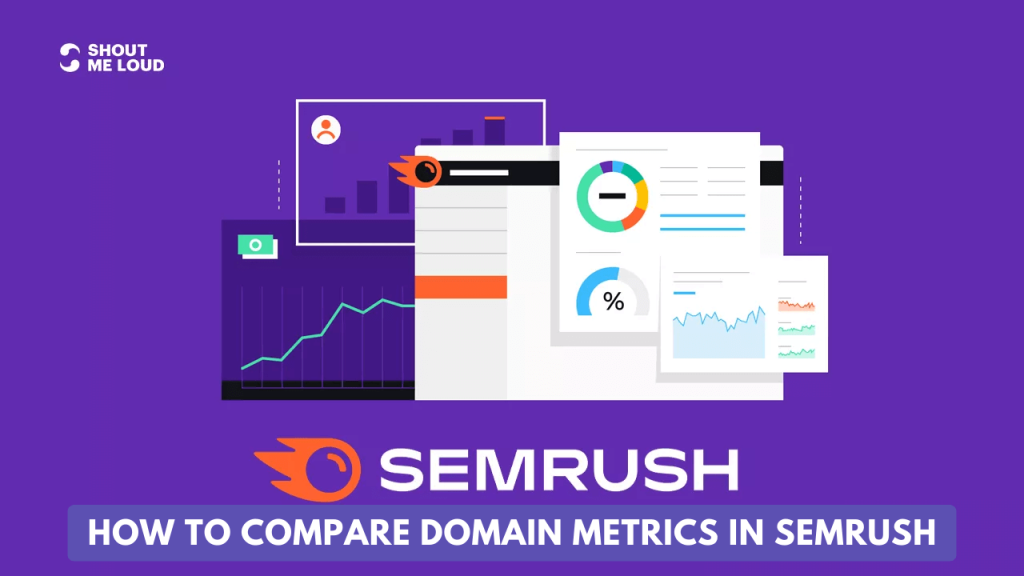In the ever-evolving landscape of online presence, understanding and comparing domain metrics play a pivotal role in strategic decision-making for businesses and individuals alike. Domain metrics provide valuable insights into the performance, visibility, and authority of a website or online entity.
Jump to
ToggleBy comprehensively analyzing these metrics, stakeholders can make informed choices to enhance their online strategies, optimize content, and stay competitive in the digital realm.
One powerful tool that facilitates the analysis of domain metrics is SEMrush. SEMrush is a comprehensive and versatile software suite designed for digital marketing professionals, SEO specialists, and anyone seeking to gain a competitive edge in the online space. It offers a wide array of features, with a particular focus on domain analysis, keyword research, and competitor intelligence.
Importance of Comparing Domain Metrics
Understanding the significance of comparing domain metrics is crucial for several reasons. Firstly, it allows businesses to assess their own performance and identify areas for improvement. Metrics such as organic traffic, backlinks, and keyword rankings provide valuable insights into the effectiveness of an online strategy.
Secondly, comparing domain metrics enables benchmarking against competitors. By evaluating how well a website performs in comparison to industry rivals, businesses can identify opportunities, pinpoint weaknesses, and develop strategies to outperform competitors.
Moreover, domain metrics contribute to a website’s search engine optimization (SEO) efforts. Search engines consider various metrics when determining the relevance and authority of a website, and optimizing these metrics can lead to improved search rankings. This, in turn, enhances visibility, drives organic traffic, and strengthens the overall online presence.
SEMrush as a Tool for Analyzing Domain Metrics
SEMrush stands out as a powerful ally in the realm of digital marketing and SEO. It offers a comprehensive suite of tools that enable users to analyze and compare domain metrics effectively. Some key features of SEMrush include:
- Domain Overview: Provides a snapshot of a website’s performance, including organic search traffic, backlink profile, and paid search metrics.
- Keyword Research: Helps users identify relevant keywords for their niche, understand search volume, and analyze the competition for specific keywords.
- Competitor Analysis: Allows users to compare their domain metrics against competitors, identify gaps in their strategies, and uncover opportunities for improvement.
- Backlink Analysis: Offers insights into a website’s backlink profile, helping users assess the quality and quantity of backlinks and identify potential areas for link-building.
- Site Audit: Evaluates the technical health of a website, identifying issues that may impact SEO performance.
SEMrush plays a pivotal role in the digital marketing landscape by providing a robust platform for analyzing and comparing domain metrics. Its multifaceted tools empower users to make data-driven decisions, optimize their online presence, and stay ahead in the dynamic and competitive world of digital marketing.
Understanding Domain Metrics
To comprehensively assess a website’s performance and visibility on the internet, it’s crucial to delve into key domain metrics that offer insights into various aspects of online presence. Here, we’ll explore some of the essential domain metrics and discuss their significance in evaluating a website’s effectiveness.
Organic Search Traffic:
Organic search traffic refers to the number of visitors a website receives through non-paid (organic) search engine results. It is a key metric that reflects the site’s visibility on search engine results pages (SERPs) and indicates how well it is optimized for search engines.
Importance: High organic search traffic suggests that the website is effectively targeting relevant keywords, providing valuable content, and attracting users through search engine queries. It is a fundamental metric for assessing the overall reach and impact of a website.
Backlink Profile:
A backlink profile comprises all the links pointing to a website from external sources. These links, also known as backlinks, play a crucial role in establishing a site’s authority and credibility in the eyes of search engines.
Importance: A strong backlink profile is indicative of a website’s popularity and trustworthiness. Search engines consider the quality and quantity of backlinks when determining a site’s authority, and a robust backlink profile can positively influence search rankings.
Keyword Rankings:
Keyword rankings denote a website’s position in search engine results for specific keywords. Monitoring keyword rankings helps assess how well a site is performing for targeted terms relevant to its content and niche.
Importance: Higher keyword rankings signify better visibility on search engines, leading to increased organic traffic. Tracking keyword rankings allows website owners to understand which terms are driving traffic and identify opportunities for improvement in their SEO strategy.
Page Load Speed:
Page load speed measures how quickly a web page loads for users. It is a critical factor in user experience and can impact both search engine rankings and user satisfaction.
Importance: Search engines prioritize fast-loading websites as they provide a better user experience. Slow-loading pages may result in higher bounce rates and negatively affect a site’s SEO performance.
Bounce Rate:
Bounce rate represents the percentage of visitors who navigate away from a site after viewing only one page. It is an indicator of how engaging and relevant a website’s content is to its visitors.
Importance: A high bounce rate may suggest that visitors are not finding the content they expected, highlighting potential issues with relevance or user experience. Lowering the bounce rate is often a goal for improving overall website performance.
Understanding key domain metrics is essential for gaining a holistic view of a website’s performance. These metrics collectively provide valuable insights into the effectiveness of SEO strategies, content quality, and user experience. By regularly monitoring and optimizing these metrics, website owners can enhance their online presence, attract more visitors, and achieve their digital marketing objectives.
Using SEMrush for Domain Metrics Comparison
SEMrush offers a user-friendly domain comparison tool that allows digital marketers, SEO specialists, and website owners to compare key metrics of multiple domains. Here’s a step-by-step guide on how to access the domain comparison tool and input domain names for comparison:
1. Accessing SEMrush:
Open your web browser and navigate to the SEMrush website (https://www.semrush.com/).
Log in to your SEMrush account. If you don’t have an account, you can sign up for a free or premium account.
2. Navigating to Domain Analytics:
Once logged in, you will find a navigation bar at the top of the SEMrush dashboard. Click on the “Domain Analytics” tab to reveal a dropdown menu.
3. Selecting Domain Overview:
In the dropdown menu, click on “Overview.” This will take you to the Domain Overview section, where you can input domain names for comparison.
4. Accessing Domain Comparison Tool:
Within the Domain Overview section, look for the “Add Competitors” button. This button is the gateway to SEMrush’s domain comparison tool.
5. Inputting Domain Names:
Click on the “Add Competitors” button to open the domain comparison tool.
In the tool, you will see input fields where you can add the domain names you want to compare. You can input up to five domains for comparison.
6. Entering Domain Names:
Type or paste the domain names into the respective input fields. Ensure that each domain is entered on a separate line.
After entering the domain names, click on the “Compare” or “Go” button to initiate the domain metrics comparison.
7. Viewing Domain Comparison Metrics:
SEMrush will generate a comparative analysis report, presenting key metrics for the entered domains. These metrics may include organic search traffic, backlink profiles, keyword rankings, and more.
8. Interpreting the Results:
Analyze the results to gain insights into how each domain performs in comparison to the others. SEMrush’s intuitive interface provides visual representations and detailed data to help you make informed decisions.
9. Exploring Detailed Metrics:
SEMrush allows users to delve deeper into specific metrics by clicking on the respective sections. For example, you can explore detailed information on organic search, backlinks, and other aspects of each domain’s performance.
By following these steps, users can efficiently leverage SEMrush’s domain comparison tool to gain valuable insights into the strengths and weaknesses of multiple domains. This information is instrumental in refining digital strategies, understanding market competition, and making data-driven decisions to enhance online performance.
Interpreting Domain Comparison Data
Comparing domain metrics through tools like SEMrush provides a wealth of information that can be crucial for refining digital strategies and gaining a competitive edge. Let’s delve into the key aspects of interpreting domain comparison data, focusing on analyzing organic search traffic, understanding backlink profiles, and comparing keyword rankings along with organic visibility.
- Analyzing Organic Search Traffic Comparison:
- Metrics to Consider:
- Organic Search Traffic Volume: Look at the total organic search traffic each domain receives. A higher volume suggests better visibility and effective SEO strategies.
- Traffic Trends: Analyze trends over time to identify growth or decline in organic traffic. Consider seasonal variations and correlate with major website updates.
- Interpretation:
- A domain with consistently increasing organic search traffic may indicate successful SEO efforts and content optimization.
- Significant drops in traffic might signal issues such as algorithmic penalties or technical issues that need attention.
- Metrics to Consider:
- Understanding Backlink Profile Comparison:
- Metrics to Consider:
- Total Backlinks: Assess the overall number of backlinks. Higher numbers indicate a strong backlink profile.
- Referring Domains: Examine the diversity of referring domains. A diverse backlink profile is often more valuable than a high quantity from a single source.
- Quality of Backlinks: Evaluate the authority of domains providing backlinks. High-authority links contribute more to a website’s credibility.
- Interpretation:
- A domain with a robust backlink profile from diverse and authoritative sources is likely to have higher search engine rankings.
- Sudden spikes or drops in backlink numbers may require investigation, as they could be the result of intentional strategies or spam-related issues.
- Metrics to Consider:
- Comparing Keyword Rankings and Organic Visibility:
- Metrics to Consider:
- Top Ranking Keywords: Identify the number of keywords each domain ranks for within the top positions. High rankings for relevant keywords enhance organic visibility.
- Organic Visibility Score: SEMrush often provides a visibility score, summarizing a domain’s overall presence in search results based on its keyword rankings.
- Interpretation:
- Domains with a high number of top-ranking keywords and a strong visibility score are likely to attract more organic traffic.
- Monitor changes in keyword rankings, especially for critical terms, as they can impact a site’s overall performance in search results.
- Metrics to Consider:
- Additional Considerations:
- Competitor Benchmarks: Compare the metrics against industry benchmarks and competitors to contextualize the data.
- User Experience Metrics: Factors such as page load speed and bounce rates influence user experience, indirectly affecting SEO. Consider these metrics in conjunction with others for a holistic view.
Interpreting domain comparison data requires a nuanced understanding of various metrics and their interplay. Regular monitoring and analysis of these metrics enable website owners and digital marketers to adapt strategies, capitalize on strengths, and address weaknesses, ultimately contributing to sustained online success.
Leveraging Domain Comparison Insights
Once you’ve gathered and analyzed domain comparison data through tools like SEMrush, the next crucial step is to leverage these insights to inform your SEO and marketing strategy. Here’s a guide on how to utilize the comparison data effectively, identify opportunities, and address weaknesses for strategic improvement.
- Informing SEO and Marketing Strategy:
- Identify Top-Performing Strategies:
- Analyze the domains that excel in organic search traffic, backlink profiles, and keyword rankings. Identify the strategies that contribute to their success, such as content quality, link-building tactics, or keyword targeting.
- Benchmark Against Competitors:
- Compare your domain’s metrics with those of key competitors. Understand what they are doing well and where you can improve. Benchmarking provides context for setting realistic goals and targets.
- Focus on High-Impact Keywords:
- Prioritize optimization efforts for keywords that drive traffic to top-performing domains. Tailor your content and SEO strategies to enhance visibility for these high-impact keywords.
- Identify Top-Performing Strategies:
- Identifying Opportunities:
- Content Gap Analysis:
- Identify topics and keywords where top-performing domains excel but your site lacks coverage. Develop content strategies to fill these gaps and provide valuable information that attracts your target audience.
- Backlink Opportunities:
- Explore domains linking to competitors but not to your site. Identify opportunities for outreach and collaboration to build a diverse and high-quality backlink profile.
- Keyword Expansion:
- Discover related keywords for which top-performing domains rank. Expand your keyword targeting strategy to capture a broader audience and increase organic visibility.
- Content Gap Analysis:
- Addressing Weaknesses:
- Technical SEO Optimization:
- If your domain lags in organic search traffic or keyword rankings, conduct a thorough technical SEO audit. Address issues such as page load speed, mobile optimization, and crawl errors to improve overall website health.
- Content Enhancement:
- Assess the quality and relevance of your content compared to top-performing domains. Enhance existing content, create new, engaging material, and ensure it aligns with user intent and search engine algorithms.
- Link-Building Strategies:
- If your backlink profile is weaker than competitors, focus on sustainable link-building strategies. Outreach to authoritative websites, participate in industry collaborations, and create shareable content to attract natural backlinks.
- Technical SEO Optimization:
- Iterative Analysis and Adaptation:
- Regular Monitoring:
- Continuously monitor domain metrics and revisit the comparison analysis regularly. Changes in the digital landscape, search engine algorithms, or industry trends may necessitate adjustments to your strategies.
- Iterative Improvement:
- Treat SEO and marketing strategy as an iterative process. Implement changes based on insights gained from domain comparison data, track the impact, and refine your approach over time.
- Regular Monitoring:
By leveraging domain comparison insights in this manner, you can transform raw data into actionable strategies that enhance your website’s performance, strengthen its online presence, and keep your digital strategy adaptive and competitive in the dynamic landscape of the internet.
Conclusion
In conclusion, the process of comparing domain metrics using SEMrush yields invaluable insights that can significantly impact the success of your digital strategies. Let’s recap the benefits of utilizing SEMrush for domain comparison and encourage readers to apply these insights for strategic advancement.
- Recap of Benefits:
- Holistic Performance Assessment: SEMrush provides a comprehensive view of domain metrics, encompassing organic search traffic, backlink profiles, keyword rankings, and more. This holistic approach allows for a thorough assessment of a website’s overall performance.
- Competitive Analysis: By comparing your domain metrics with those of competitors, you gain a clear understanding of your relative standing in the market. This insight helps identify strengths, weaknesses, and areas for improvement.
- Strategic Benchmarking: SEMrush enables you to benchmark your domain against industry standards and top-performing websites. This benchmarking process serves as a guide for setting realistic goals and optimizing strategies for maximum impact.
- Data-Driven Decision Making: The wealth of data provided by SEMrush empowers you to make informed, data-driven decisions. Whether it’s refining content strategies, optimizing for specific keywords, or enhancing backlink profiles, SEMrush’s insights guide your strategic choices.
- Encouragement to Apply Domain Comparison Insights:
- Adaptability in the Digital Landscape: The digital landscape is dynamic, and staying ahead requires constant adaptation. Applying insights gained from domain comparison allows you to adapt your strategies in real-time, ensuring relevance and competitiveness.
- Continuous Improvement: Your digital strategies should be viewed as a continuous improvement process. Regularly revisit domain comparison analyses, identify new opportunities, address weaknesses, and refine your approach iteratively.
- Strategic Alignment with Goals: SEMrush’s domain comparison tool aligns your strategies with your overarching goals. Whether the focus is on increasing organic traffic, building a robust backlink profile, or dominating specific keywords, SEMrush aids in aligning your efforts for success.
- Stay Ahead of Trends: The insights gained from domain comparison not only inform current strategies but also position you to stay ahead of emerging trends. Being proactive in adapting to changes in the digital landscape ensures sustained success.
In essence, the journey of comparing domain metrics using SEMrush is not merely an analytical exercise; it’s a dynamic process that fuels strategic evolution. By embracing the insights gleaned from this comparison, you empower your digital presence to thrive, outperform competitors, and navigate the ever-changing digital landscape with confidence. Apply these insights judiciously, and watch as your digital strategies reach new heights of effectiveness and impact.







